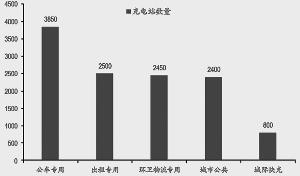
New target plan for charging stations by 2020 (Unit: seat)
Source: National Development and Reform Commission, GF Securities Development Research Center

New target planning for charging piles by 2020
(Unit: 10,000)
Source: National Development and Reform Commission, GF Securities Development Research Center

Total output and forecast of new energy vehicles
Source of data: China Automobile Association, Guangfa Securities Development Research Center

New energy vehicle total inventory and forecast
growth rate
Source of data: China Automobile Association, Guangfa Securities Development Research Center
The dual-integration policy has played a pivotal role in steering the industry toward sustainable development. As electric vehicles reach cost parity with traditional fuel cars, this shift is expected to accelerate adoption. The introduction of the double-point system marks a strategic move from direct subsidies to a more market-driven approach. This policy encourages automakers to produce more new energy vehicles, which will not only benefit the environment but also drive innovation within the sector. With the global push for more charging infrastructure, equipment manufacturers are poised to benefit significantly. It's projected that the charging pile market could hit 38.7 billion yuan over the next three years, offering substantial profit potential. In the long term, the operation of charging stations is anticipated to become a major investment area, as operators refine their business models and expand value-added services. The dual-point system has been instrumental in supporting the growth of new energy vehicles. Introduced in 2017, it aims to balance fuel consumption and new energy points, ensuring that traditional car companies contribute to the production of electric vehicles. This system not only promotes high-energy-density batteries but also enhances the competitiveness of electric vehicles in the market. Looking ahead, the market for new energy vehicles is expected to grow rapidly. Sales are anticipated to rise between 45% and 60% in 2018, reaching approximately 1.1 million units. This growth is supported by both policy incentives and the increasing demand for eco-friendly transportation solutions. As battery technology advances, the cost of electric vehicles is expected to decrease, making them more accessible to a broader consumer base. In terms of raw materials, cobalt remains a critical component in the production of ternary batteries. With rising demand driven by the expansion of the electric vehicle market, cobalt prices are expected to remain stable or even increase. On the other hand, lithium carbonate faces a more balanced supply and demand scenario, with prices likely to stabilize as production scales up. The charging infrastructure sector is also gaining momentum. With government support shifting towards the construction and operation of charging stations, the industry is set for significant growth. Equipment providers stand to benefit from increased demand, while operators are expected to explore innovative business models to enhance profitability. Overall, the future of the new energy vehicle industry looks promising. With continued policy support, technological advancements, and growing consumer demand, the sector is well-positioned for sustained growth and development.On grid solar system,Microgrid power system,outdoor energy storage cabinet,renewable energy storage system,Behind the meter battery storage
EMoreShare International Trade (Suzhou) Co., Ltd , https://www.emoreshare.com